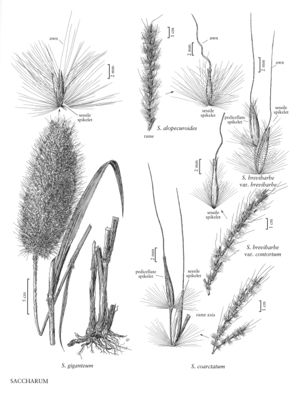Difference between revisions of "Saccharum coarctatum"
FNA>Volume Importer |
FNA>Volume Importer |
||
| Line 7: | Line 7: | ||
|synonyms={{Treatment/ID/Synonym | |synonyms={{Treatment/ID/Synonym | ||
|name=Erianthus coarctatus | |name=Erianthus coarctatus | ||
| − | |authority= | + | |authority= |
| + | |rank=species | ||
}} | }} | ||
|hierarchy=Poaceae;Poaceae subfam. Panicoideae;Poaceae tribe Andropogoneae;Saccharum;Saccharum coarctatum | |hierarchy=Poaceae;Poaceae subfam. Panicoideae;Poaceae tribe Andropogoneae;Saccharum;Saccharum coarctatum | ||
| Line 20: | Line 21: | ||
-->{{Treatment/Body | -->{{Treatment/Body | ||
|distribution=Md.;Tex.;Va.;Del.;N.C.;Ala.;Ga.;S.C.;Fla. | |distribution=Md.;Tex.;Va.;Del.;N.C.;Ala.;Ga.;S.C.;Fla. | ||
| − | |discussion=<p>Saccharum coarctatum is common in wet, peaty or sandy soils of swales, pond margins, and meadows of the coastal plain of the southeastern United States. It is unusual in having lodicule veins that extend into hairlike projections up to 0.6 mm long.</p> | + | |discussion=<p><i>Saccharum coarctatum</i> is common in wet, peaty or sandy soils of swales, pond margins, and meadows of the coastal plain of the southeastern United States. It is unusual in having lodicule veins that extend into hairlike projections up to 0.6 mm long.</p> |
|tables= | |tables= | ||
|references= | |references= | ||
| Line 29: | Line 30: | ||
-->{{#Taxon: | -->{{#Taxon: | ||
name=Saccharum coarctatum | name=Saccharum coarctatum | ||
| − | |||
|authority=(Fernald) R.D. Webster | |authority=(Fernald) R.D. Webster | ||
|rank=species | |rank=species | ||
| Line 36: | Line 36: | ||
|basionyms= | |basionyms= | ||
|family=Poaceae | |family=Poaceae | ||
| − | |illustrator=Linda A. Vorobik | + | |illustrator=Linda A. Vorobik;Hana Pazdírková |
| + | |illustration copyright=Utah State University | ||
|distribution=Md.;Tex.;Va.;Del.;N.C.;Ala.;Ga.;S.C.;Fla. | |distribution=Md.;Tex.;Va.;Del.;N.C.;Ala.;Ga.;S.C.;Fla. | ||
|reference=None | |reference=None | ||
| Line 42: | Line 43: | ||
|publication year= | |publication year= | ||
|special status= | |special status= | ||
| − | |source xml=https:// | + | |source xml=https://jpend@bitbucket.org/aafc-mbb/fna-data-curation.git/src/f50eec43f223ca0e34566be0b046453a0960e173/coarse_grained_fna_xml/V25/V25_1506.xml |
|subfamily=Poaceae subfam. Panicoideae | |subfamily=Poaceae subfam. Panicoideae | ||
|tribe=Poaceae tribe Andropogoneae | |tribe=Poaceae tribe Andropogoneae | ||
Revision as of 21:34, 16 December 2019
Plants cespitose, not or shortly rhizomatous. Culms 1-2.5 m; nodes with 1-3 mm hairs. Sheaths glabrous; auricles 0.3-3 mm; ligules 1-2 mm; blades 15-40 cm long, 7-12 mm wide. Peduncles 35-45 cm, glabrous; panicles 3-7 cm wide, linear to oblong; rachises 13-35 cm, glabrous or sparsely pilose; primary branches 5-12 cm, appressed; rame internodes 3-6 mm, with hairs. Sessile spikelets 6-8 mm long, 0.9-1.2 mm wide, brown. Callus hairs 3-5 mm, from shorter than to equaling the spikelets, white or straw-colored; lower glumes smooth or scabrous, 5-veined; lower lemmas 5.8-7.5 mm, usually 3-veined; upper lemmas 4-5.5 mm, 0.7-0.8 times as long as the lower lemmas, 3-veined, entire; awns 16-26 mm, terete and straight to curving basally; lodicule veins extending into hairlike projections to 0.6 mm long; anthers 2. Pedicels 3-5 mm, sparsely and shortly pilose. Pedicellate spikelets similar to the sessile spikelets. 2n = 60.
Distribution
Md., Tex., Va., Del., N.C., Ala., Ga., S.C., Fla.
Discussion
Saccharum coarctatum is common in wet, peaty or sandy soils of swales, pond margins, and meadows of the coastal plain of the southeastern United States. It is unusual in having lodicule veins that extend into hairlike projections up to 0.6 mm long.
Selected References
None.
